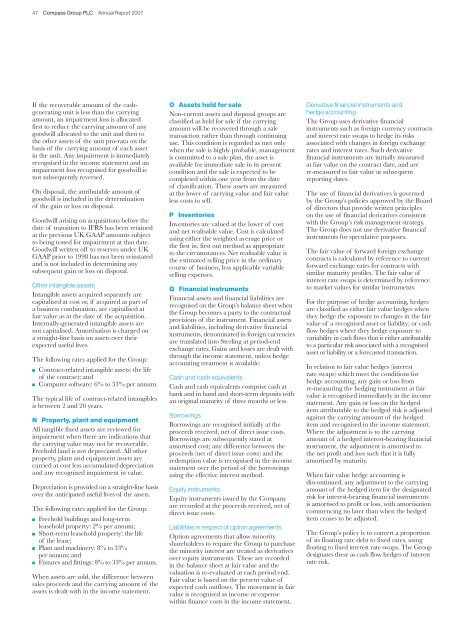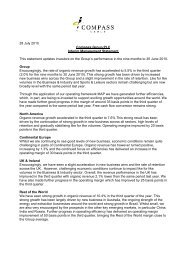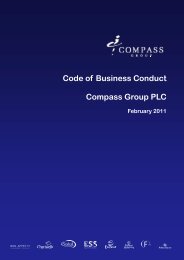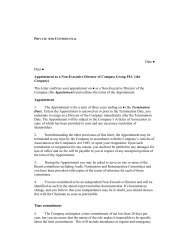2568.11 kb - Compass Group
2568.11 kb - Compass Group
2568.11 kb - Compass Group
You also want an ePaper? Increase the reach of your titles
YUMPU automatically turns print PDFs into web optimized ePapers that Google loves.
47 <strong>Compass</strong> <strong>Group</strong> PLC Annual Report 2007If the recoverable amount of the cashgeneratingunit is less than the carryingamount, an impairment loss is allocatedfirst to reduce the carrying amount of anygoodwill allocated to the unit and then tothe other assets of the unit pro-rata on thebasis of the carrying amount of each assetin the unit. Any impairment is immediatelyrecognised in the income statement and animpairment loss recognised for goodwill isnot subsequently reversed.On disposal, the attributable amount ofgoodwill is included in the determinationof the gain or loss on disposal.Goodwill arising on acquisitions before thedate of transition to IFRS has been retainedat the previous UK GAAP amounts subjectto being tested for impairment at that date.Goodwill written off to reserves under UKGAAP prior to 1998 has not been reinstatedand is not included in determining anysubsequent gain or loss on disposal.Other intangible assetsIntangible assets acquired separately arecapitalised at cost or, if acquired as part ofa business combination, are capitalised atfair value as at the date of the acquisition.Internally-generated intangible assets arenot capitalised. Amortisation is charged ona straight-line basis on assets over theirexpected useful lives.The following rates applied for the <strong>Group</strong>:Contract-related intangible assets: the lifeof the contract; andComputer software: 6% to 33% per annum.The typical life of contract-related intangiblesis between 2 and 20 years.N Property, plant and equipmentAll tangible fixed assets are reviewed forimpairment when there are indications thatthe carrying value may not be recoverable.Freehold land is not depreciated. All otherproperty, plant and equipment assets arecarried at cost less accumulated depreciationand any recognised impairment in value.Depreciation is provided on a straight-line basisover the anticipated useful lives of the assets.The following rates applied for the <strong>Group</strong>:Freehold buildings and long-termleasehold property: 2% per annum;Short-term leasehold property: the lifeof the lease;Plant and machinery: 8% to 33%per annum; andFixtures and fittings: 8% to 33% per annum.When assets are sold, the difference betweensales proceeds and the carrying amount of theassets is dealt with in the income statement.O Assets held for saleNon-current assets and disposal groups areclassified as held for sale if the carryingamount will be recovered through a saletransaction rather than through continuinguse. This condition is regarded as met onlywhen the sale is highly probable, managementis committed to a sale plan, the asset isavailable for immediate sale in its presentcondition and the sale is expected to becompleted within one year from the dateof classification. These assets are measuredat the lower of carrying value and fair valueless costs to sell.P InventoriesInventories are valued at the lower of costand net realisable value. Cost is calculatedusing either the weighted average price orthe first in, first out method as appropriateto the circumstances. Net realisable value isthe estimated selling price in the ordinarycourse of business, less applicable variableselling expenses.Q Financial instrumentsFinancial assets and financial liabilities arerecognised on the <strong>Group</strong>’s balance sheet whenthe <strong>Group</strong> becomes a party to the contractualprovisions of the instrument. Financial assetsand liabilities, including derivative financialinstruments, denominated in foreign currenciesare translated into Sterling at period-endexchange rates. Gains and losses are dealt withthrough the income statement, unless hedgeaccounting treatment is available.Cash and cash equivalentsCash and cash equivalents comprise cash atbank and in hand and short-term deposits withan original maturity of three months or less.BorrowingsBorrowings are recognised initially at theproceeds received, net of direct issue costs.Borrowings are subsequently stated atamortised cost; any difference between theproceeds (net of direct issue costs) and theredemption value is recognised in the incomestatement over the period of the borrowingsusing the effective interest method.Equity instrumentsEquity instruments issued by the Companyare recorded at the proceeds received, net ofdirect issue costs.Liabilities in respect of option agreementsOption agreements that allow minorityshareholders to require the <strong>Group</strong> to purchasethe minority interest are treated as derivativesover equity instruments. These are recordedin the balance sheet at fair value and thevaluation is re-evaluated at each period end.Fair value is based on the present value ofexpected cash outflows. The movement in fairvalue is recognised as income or expensewithin finance costs in the income statement.Derivative financial instruments andhedge accountingThe <strong>Group</strong> uses derivative financialinstruments such as foreign currency contractsand interest rate swaps to hedge its risksassociated with changes in foreign exchangerates and interest rates. Such derivativefinancial instruments are initially measuredat fair value on the contract date, and arere-measured to fair value at subsequentreporting dates.The use of financial derivatives is governedby the <strong>Group</strong>’s policies approved by the Boardof directors that provide written principleson the use of financial derivatives consistentwith the <strong>Group</strong>’s risk management strategy.The <strong>Group</strong> does not use derivative financialinstruments for speculative purposes.The fair value of forward foreign exchangecontracts is calculated by reference to currentforward exchange rates for contracts withsimilar maturity profiles. The fair value ofinterest rate swaps is determined by referenceto market values for similar instruments.For the purpose of hedge accounting, hedgesare classified as either fair value hedges whenthey hedge the exposure to changes in the fairvalue of a recognised asset or liability; or cashflow hedges where they hedge exposure tovariability in cash flows that is either attributableto a particular risk associated with a recognisedasset or liability or a forecasted transaction.In relation to fair value hedges (interestrate swaps) which meet the conditions forhedge accounting, any gain or loss fromre-measuring the hedging instrument at fairvalue is recognised immediately in the incomestatement. Any gain or loss on the hedgeditem attributable to the hedged risk is adjustedagainst the carrying amount of the hedgeditem and recognised in the income statement.Where the adjustment is to the carryingamount of a hedged interest-bearing financialinstrument, the adjustment is amortised tothe net profit and loss such that it is fullyamortised by maturity.When fair value hedge accounting isdiscontinued, any adjustment to the carryingamount of the hedged item for the designatedrisk for interest-bearing financial instrumentsis amortised to profit or loss, with amortisationcommencing no later than when the hedgeditem ceases to be adjusted.The <strong>Group</strong>’s policy is to convert a proportionof its floating rate debt to fixed rates, usingfloating to fixed interest rate swaps. The <strong>Group</strong>designates these as cash flow hedges of interestrate risk.








